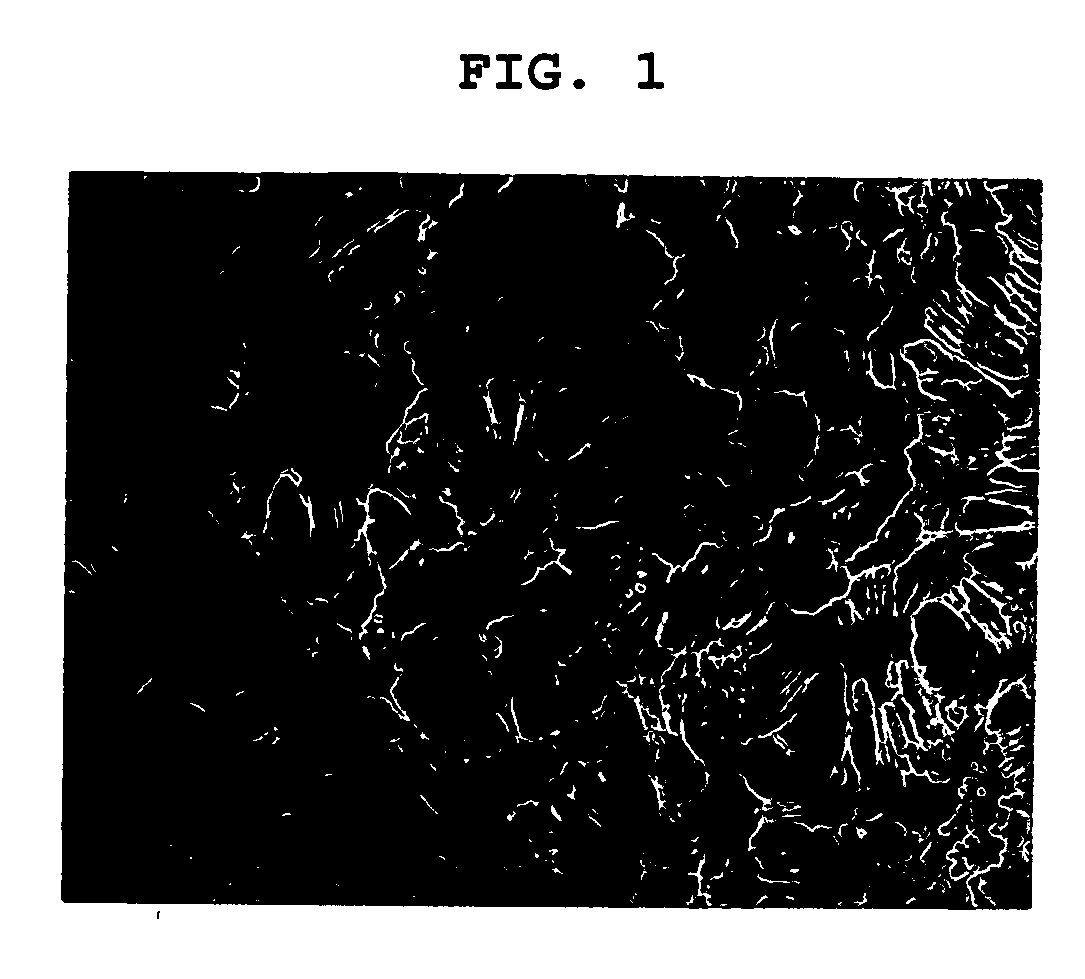Ethylene polymer particle, production method thereof and molded article using the same
a technology of ethylene polymer and ethylene polymer, which is applied in the field of ethylene polymer particles, can solve the problems that ethylene polymers with ultra-high molecular weight are not suitable for melt molding, and achieve the effects of high molecular weight, specific surface shape, and high degree of crystallinity
- Summary
- Abstract
- Description
- Claims
- Application Information
AI Technical Summary
Benefits of technology
Problems solved by technology
Method used
Image
Examples
example 1
Preparation of Solid Titanium Catalyst Component [A1]
[0227] 75 g of anhydrous magnesium chloride, 280.3 g of decane and 308.3 g of 2-ethylhexyl alcohol were reacted by heating at 130° C. for 3 hours to give a homogeneous solution. Then, into this solution was added 19.9 g of 2-isobutyl-2-isopropyl-1,3-dimethoxypropane. The mixture was stirred at 100° C. for 1 hour.
[0228] The homogeneous solution thus obtained was cooled down to room temperature, and then 30 ml of this homogeneous solution was added dropwise to 80 ml of titanium tetrachloride kept at −20° C. with stirring over 45 minutes. After completion of the dropwise addition, the temperature of this mixed liquid was raised up to 110° C. in 6 hours. When the temperature reached 110° C., 0.55 g of 2-isobutyl-2-isopropyl-1,3-dimethoxypropane was added into the mixed liquid, and the mixture was kept at the same temperature for 2 hours with stirring. After completion of the reaction for 2 hours, a solid part was collected by hot fil...
example 2
[0233] First step: Into a sufficiently nitrogen-purged polymerization vessel having a content volume of 1 liter was added 500 ml of purified heptane at room temperature, and 0.5 mmol of triisobutylaluminum as the organometallic compound catalyst component [B1] and 0.005 mmol in terms of titanium atom of the solid titanium catalyst component [A1] were added under an ethylene atmosphere at 78° C. Subsequently, 75 ml of hydrogen was added, and then ethylene polymerization was performed at a temperature of 80° C. for 1 hour by feeding ethylene at a constant rate of 0.4 liter / min. At this time point, 10 ml of the slurry was sampled from the polymerization vessel. The slurry was filtrated and the residue was dried to give a white solid. The intrinsic viscosity [η] of this white solid was measured to be 8.5 dl / g.
[0234] Second step: After completion of the polymerization, the vessel was purged with ethylene and hydrogen and the pressure was returned to normal pressure. Then,...
example 3
[0241] Polymerization was carried out in the same manner as in Example 2 except that the amount of hydrogen was 150 ml and the polymerization time was 48 minutes in the first step and the amount of hydrogen was 20 ml and the polymerization time was 110 minutes in the second step. Further, by means of a sieve with a mesh size of 355 μm, particles with a particle diameter of 355 μm or more were removed.
[0242] The resultant ethylene polymer particles had an intrinsic viscosity [η] of 22.2 dl / g, a degree of crystallinity of 83%, and an average particle diameter of 200 μm. The polymerization activity was 19,900 g / mmol-Ti. Inclusion of particles with a particle diameter of 355 μm or more was not recognized.
[0243] The polymer obtained in the first step had an intrinsic viscosity [η] of 6.3 dl / g. The ratio of polymerization amounts in the first step to the second step, first step / second step, was 2 / 8 by weight. The polymer produced in the second step had an intrinsic viscos...
PUM
| Property | Measurement | Unit |
|---|---|---|
| Temperature | aaaaa | aaaaa |
| Length | aaaaa | aaaaa |
| Length | aaaaa | aaaaa |
Abstract
Description
Claims
Application Information
 Login to View More
Login to View More - R&D
- Intellectual Property
- Life Sciences
- Materials
- Tech Scout
- Unparalleled Data Quality
- Higher Quality Content
- 60% Fewer Hallucinations
Browse by: Latest US Patents, China's latest patents, Technical Efficacy Thesaurus, Application Domain, Technology Topic, Popular Technical Reports.
© 2025 PatSnap. All rights reserved.Legal|Privacy policy|Modern Slavery Act Transparency Statement|Sitemap|About US| Contact US: help@patsnap.com



